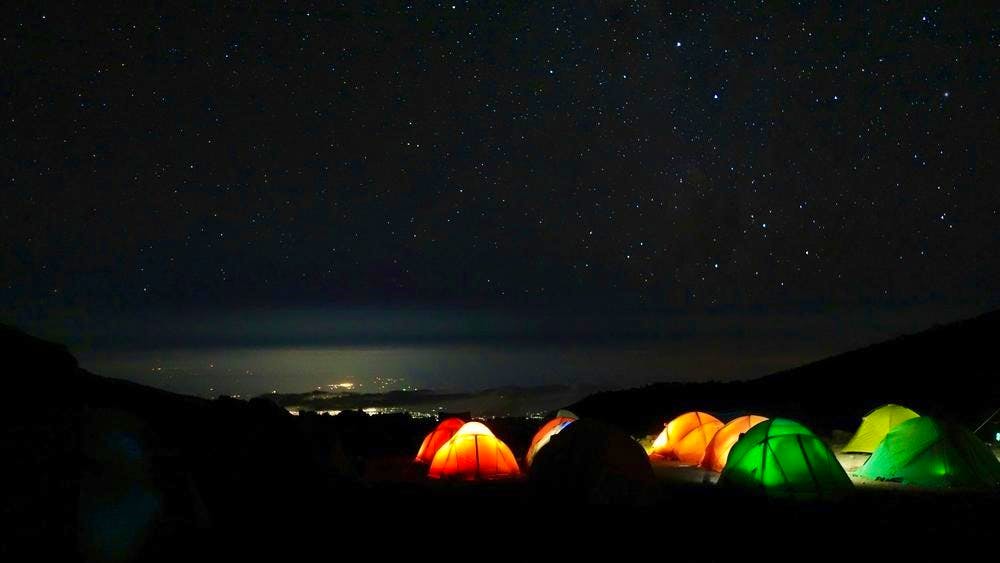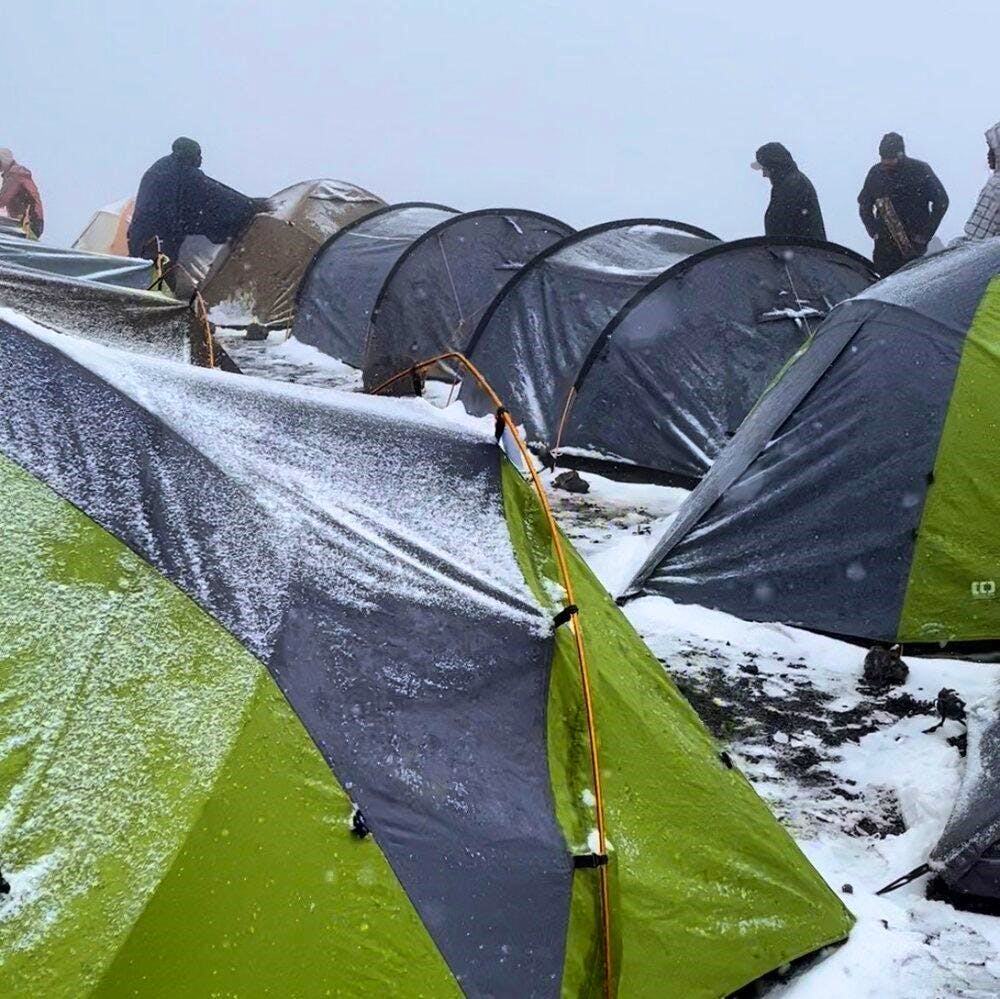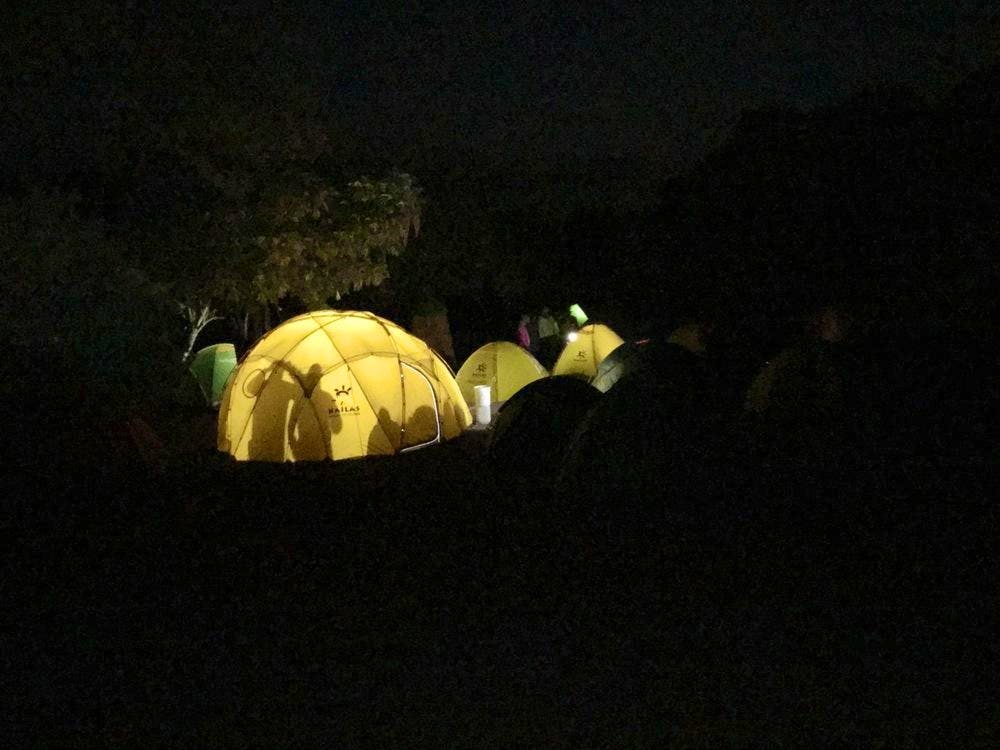Base To Summit: Overview Of The Kilimanjaro Camps
Haven't booked your adventure yet? Check out Skyhook's Kilimanjaro trips.
Overview of Kilimanjaro Camps by Route

Machame Route

Machame Camp (3,021m)
Shira 2 Camp (3,830m)
Barranco Camp (3,972m)
Karanga Camp (3,963m)
Barafu Camp (4,640m)
Millenium Camp (3,790m)
Lemosho Route

Big Tree (also known as Mti Mbukwa) Camp (2,780m)
Shira 1 Camp (3,500m)
Shira 2 Camp (3,900m)
Barranco Camp (3,960m)
Karanga Camp (3,963m)
Barafu Camp (4,640m)
Millenium Camp (3,790m)
Rongai Route

Simba Camp (2,625m)
Second Cave Camp (3,480m)
Kikelewa Camp (3,630m)
Mawenzi Tarn Camp (4,310m)
Kibo Hut (4,700m)
Horombo Hut (3,720m)
Marangu Route

Mandara Hut (2,700m)
Horombo Hut (3,700m)
Kibo Hut (4,700m)
Northern Circuit Route
Mti Mkubwa (Big Tree) Camp (2,780m)
Shira 1 Camp (3,500m)
Shira 2 Camp (3,900m)
Moir Hut Camp (4,200m)
Buffalo Camp (4,020m)
Third Cave Camp (3,800m)
School Hut Camp (4,800m)
Millenium Camp (3,790m)
Umbwe Route
Umbwe Cave Camp (2,850m)
Barranco Camp (3,960m)
Karanga Camp (3,963m)
Barafu Camp (4,670m)
Mweka Camp (3,100m)
Other High Camps on Kilimanjaro
Lava Tower Camp

Arrow Glacier Camp
Crater Camp

What to Expect at Kilimanjaro Camps?

Accommodations: Your porter crew will set up your tents at each campsite you stop at. If you’re on the Marangu route, the huts have bunk beds in dorm-style rooms.
Mess tent/dining facilities: Again, the team will set up a larger tent called a mess tent where you can take your tea and meals each day. It’s also a place where the group gets together to chat and discuss the day’s adventures. All your meals are prepared by your crew, who prepares hearty food that will carry you to the top of the mountain.
Basic restrooms: The loos on Kilimanjaro are very basic. At each campsite, there are permanent structures where you’ll find public long-drop/pit toilets. National Parks does their best to maintain these, but it’s not easy. Most of the loos don’t have doors (they are walk-around entrances), and none have flushing water. You can book a private toilet for the group through the tour operator, and this will give you access to a Porta Loo for just your group on your trek.
Water sources: Most camps have a nearby water source where the crew will get water for cooking, drinking, and washing up.
Stunning views: Kilimanjaro camps are strategically positioned to offer captivating views of the mountain's diverse landscapes, from dense rainforests to the rocky alpine zones. These vistas provide a sense of the natural wonder you're immersed in.
Space to rest: It’s so important to allow your body time to rest and acclimatise while on the trek. Most days, you’ll arrive at camp in the afternoon with some time before dinner. Take it easy, read a book, listen to some music, take off your shoes–all of these things are important for ensuring you’re in shape to carry on to the summit.
Social atmosphere: The camps foster a communal atmosphere where trekkers share their experiences and challenges. It's an opportunity to forge new friendships and bond with fellow adventurers.
Tips to Make Your Kilimanjaro Camp Stay and Hike Great

Hydrate: Drink plenty of water throughout the day, including while at camp, to combat the effects of high altitude. Staying well-hydrated helps reduce the risk of altitude sickness and keeps you energised.
Stay warm: Kilimanjaro can get quite cold, especially at night. Keep layered up and protect yourself from the elements to keep energised and help your body acclimatise.
Rest and listen to your body: Use camp stays as an opportunity to rest and recover. Listen to your body, and if you're feeling tired or unwell, don't hesitate to communicate this with your guides and rest if needed.
Socialise: Kilimanjaro attracts trekkers from around the world. Engage with fellow climbers during your camp stays. Sharing stories, experiences, and encouragement can be incredibly motivating and enjoyable.
Photograph memories: The camps provide some of the most stunning views and landscapes of your entire journey. Don't forget to capture these moments to cherish later.
Explore surroundings: Depending on the camp's location, you might have opportunities to explore the nearby terrain. Take short walks to enjoy the local flora and fauna, or relish the panoramic vistas.
Optimise nutrition: Take advantage of the hearty meals our crews provide at the camps. These meals are designed to replenish your energy and keep you strong. Make sure to eat all meals and consume enough calories to fuel your body.
Engage with your guiding team: Your guides, porters, and support crew have a wealth of knowledge about Kilimanjaro. So ask them questions, learn about the mountain's history and culture, and build a rapport with your team. Their expertise can enhance your experience.
Respect the environment: Remember to respect the environment and follow "Leave No Trace" principles. Adhering to responsible trekking practices ensures the mountain's beauty for generations to come.
Find your next adventure
Why Skyhook?
Join over 27,000 Skyhook adventurers who've used our platform to book directly with our vetted local guides, at local prices (we never markup).
Expert Local Guides
Experienced local guides, handpicked by us.
Best Prices
Never pay a markup on the local guide's price.
Exclusive Club
Earn loyalty rewards every time you travel.
Great Social Vibes
Small group tours provide a richer experience.
Stellar Feedback
Over 3,000 reviews, average of 4.9/5 stars.












